
|   |

|   |
Ravash 2020: A festival of Odissi dance and music - Dr. Nita Vidyarthi e-mail: nitavidyarthi@gmail.com Photos courtesy: Sankalpa Nrityayan November 20, 2020 After watching Ravash 2020, the online presentation of a series of Odissi dance and music by Sankalpa Nrityayan, it was really enthralling to find how the young, talented, well-known and well trained Odissi dancer Subikash Mukherjee of the Guru Kelucharan Mohapatra gharana, now under the tutelage of Guru Ratikant Mohapatra, has groomed himself to be an aesthetically alert, mature and efficient organiser of a ten-day Odissi event on the digital platform. With an austere yet artistically decorated setup comprising of earlier uploaded performances and fresh presentations of home videos, the 10 episodes curated by Subikash drew attention of the viewers towards the artistes and their arts. It was natural that the lion's share of eight days went to dance, Sankalpa Nrityayan being an eighteen odd year old Odissi dance institution spear headed by Subikash. Nevertheless, realising the importance of the mardala bols in dance, Subikash included a brilliant mardala recital by the distinguished Satchidananda Das who presented the elements of the percussion instrument beginning with a Jaman, then ragad, arasa, khondi, godi and others in adi taal. Vocal music is another essential component to enhance the appeal of a dance recital and a mellifluous offering by the renowned Dr.Sangita Gosain was a necessary inclusion. She began with the lilting ashtapadi "Kapi madhuripuna" apart from some Odiya songs like "Ghanashyamku kahogo dutikejai", "Nua nata patoli mukuta", a short Carnatic presentation "Sudhamayee sudanidhi" and a two-liner from a Bengali film number, concluding with four lines of the soul-stirring "Kuru yadu Nandana." The daily invocation was through a reverberating "Om", a short chanting, an arati with the holy flame from the burning camphor accompanied by the tinkling of a brass bell, evoking devotional mood, while seeking the blessings of the pink lotus bedecked Lord Jagannath seated on a homely altar. However, the showmanship was offered with two comperes seated on two elevations beside the deity. The ushering was soothing and definitely different. The evenings began with the choicest of a series of uploaded group presentations by Subikash and the seniors of the institution at different professional venues, followed by the invited veterans and artistes, all of whom spoke of their training, experiences and the art, so enriching for the learners for proper development and presentation of any art form. The original compositions for the group events were mostly by Guru Kelucharan Mohapatra with Pandit Bhubaneswar Misra's soaring music, re-choreographed for the group by Subikash. 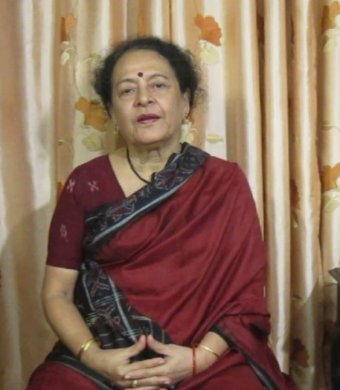 Kumkum Mohanty The first episode began with the invocation "Vinayaka smaraney" composed by Guru Ratikant Mohapatra, set to music by Vinod Kumar Panda in raga Ahir Bhairav, tala adi and jyoti by the former students of the institution. This was followed by the good wishes of Subikash's erstwhile Guruma, veteran dancer Kumkum Mohanty who praised his dedication and efforts and above all stressed on maintaining the classicism and tradition of the dance form. It was a pleasure watching her highly graceful dancing in two of her old uploaded pieces of "Yami hey" and "Natha hore." The eight group presentations included the invocation, Shankarabaranam Pallavi, Matangi Dhyanam, an Odia abhinaya "Judabandino", Dasavataar, another popular abhinaya "Dekho go sakhi Radha Madava chali", the ashtapadi "Lalita lavanga lata" and the final Desh Pallavi.  Sankalpa Nrityayan Shankarabaranam Pallavi by the group showed the imagination of Subikash's group choreography, essentially either circular or linear, while strongly maintaining the novelty of the Guru Kelucharan Mohapatra composition that was visible in every arrangement in the item. The entry of the dancers in instalments with the final sweeping appearance by Subikash to the centre, added the necessary strength to the item brightened by his final solo. The dancers were trained well enough to negotiate the intricacies of the rhythm. Worth mentioning was "Judabandino" displaying the shringar of the Devdasis through dance with the verses of Navin Das, set to traditional tunes. This abhinaya was about dressing up with flowers, sindoor, jewellery and the hair into a "juda" (bun) bringing alive the mundane chores of these women. Another Natyangiabhinaya item "Dekho go sakhi Radha Madhava chali" set to traditional tunes though seen several times has the same joyous appeal because of its song and the choreography of the procession of "Radha Madhav" in the palanquin carried at an elevated level while the onlookers (dancers) were on the stage. A striking coordination of the competent dancers makes the piece stand out. Dasavataar likewise impressed with the well-synchronised free flowing dancing as were "Lalita lavanga lata" and Desh Pallavi.  Debi Basu Beginning with the much awaited performance and reminiscences by the smiling veteran Debi Basu from Mumbai, it is true that she impresses with her distinct style marked by sensitive portrayal of whatever abhinaya she renders, be it her opening ashtapadi on Subikash's request (by her own admission) "Kapi madhuripuna" or "Pathachhadi de", which is synonymous with her. The piece has been internalised by her and distilled into a subtle form visually bright, sprinkled with some mannerisms advised by Guru Laxmipriya Mohapatra while they were training in her Cuttack house with Guru Kelucharan Mohapatra. Her anecdotes were both interesting as well as educative for a holistic development of a dancer. The encouraging affectionate words about Subikash and his abilities should take this young dancer a long way. 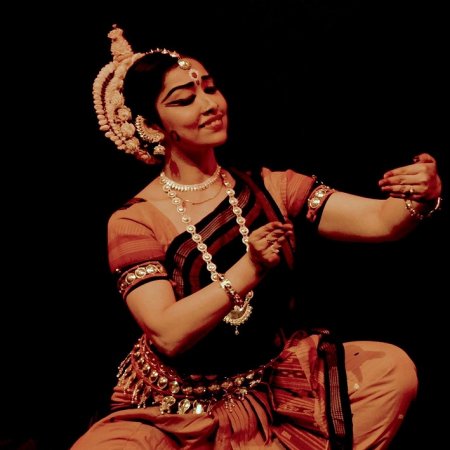 Dr. Aparupa Chatterjee Dr. Aparupa Chatterjee (US) presented a convincing "Brajaku chora aasichi" based on the pranks of little Krishna. It is a pleasure to watch her mature and offer an involved performance of the popular number especially using her expressive eyes to advantage. Kaustavi Sarkar, an erstwhile member of Sankalpa Nrityayan now in US, has blossomed into a sophisticated dancer. Her footwork and balanced Odissi movements replete with lasya elements in the Mia Malhar based item 'Varsha' composed by her Guru Poushali Mukherjee was soaked in the sargams, tarana and vistaars in abundance complementing her energetic nritta in different tempi. It was spiced with the incorporation of the singing of "Meghairameduramam baram banabhubaha" in Debashis Sarkar's baritone resulting in an overall appeal and distinctive style. In the reflection of her dance studio, her fascinating body inflexions and peacock motifs quickened the vision to unfold the succession of the Odissi vocabulary. But her attire jarred! 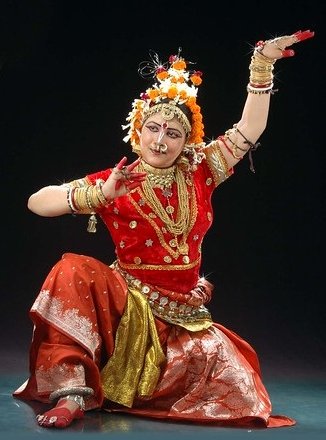 Rupashree Mohapatra It was a great privilege to watch the rarely seen Mahari Dance "Bansi teji helo" by Rupashree Mohapatra, the only artiste in Odisha to present the ritualistic dance at the Jagannath temple by the Devadasis at "Bara Shringar." In the song, Krishna is asked, "Why did you leave Radha and come to Jagannath Dham?" A foster daughter of the last of the Devadasis, Sashimoni Devi, Rupashree has kept the tradition alive through her institution Rupashree Kala Mandir, Puri, and transported the viewers to bygone eras to the temple. The dressing style and the serpentine movements in the lines "Rukhha tarulata" (dried rough creepers) and "Shankha chakra hasta ahey..." were not familiar to the viewers' eyes. Subikash must be lauded for offering this gratifying experience. 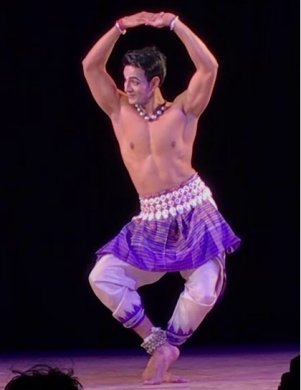 Rahul Varshney Among the four male dancers, both Lingaraj Pradhan and Rahul Varshney could not offer a fresh piece and uploaded two of their older performances because of leg injuries. Both these consummate dancers spoke of their training. Rahul being from the Guru Debaprasad gharana uploaded "Bada sthayi" in ektali, an old traditional composition in which footwork is given more style with flexibility and strength. He spoke of Debaprasad Das' 'Sabdaswarapatha' in the Guru's signature piece Kalavati Pallavi. The robust composition could be watched in Rahul's execution especially in the lovely bhramaris. He mentioned that Guru Srinath Rout had added a few tisra and chaturashra jatis in the Ektali Pallavi which according to Das had made it more attractive. An interesting addition was a short cloth fan attached from the waist under the 'bengapatiya' (silver Odissi belt) in front of the traditional costume! Lingaraj Pradhan is a dancer of high calibre and his "Shiva Ashtakam" at the Mukteswar Dance Festival was magnificent and once again a delight to watch. 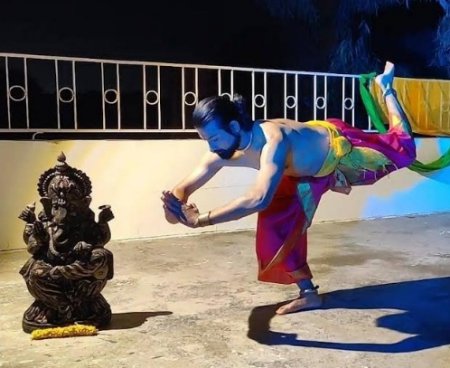 Rakesh Sai Babu Rakesh Sai Babu is a consummate Mayurbhanj Chhau dancer and a strong performer of the present generation with excellent physicality. He explained the basics of Chhau and presented his first piece 'Nataraj' portraying Shiva as the creator, preserver and destroyer. With the strong effect of shehnai and drums, every movement clearly identified meaning and the dancer transformed the movement content into the original theme as interestingly as possible. He used different combinations of action, effort, space and relationship aspects, sometimes tracing peripheral pathways to forward medium, hands leading or balancing on one foot with hands holding the raised another, low to high with firm slow quality throughout. The next item "Yodhha" was a thrilling martial art act with talwar (sword) and dhaal (shield) embellished with defence movements with basic foot movement of the style and the shehnai keeping pace with increasing laya of performance. The performance with sparkling energy, in high physical dancing power is a wonderful experience!  Subikash Mukherjee Subikash Mukherjee's compelling performance with three items closed Ravash 2020. The Mangalacharan was "Namami Vighnaraja", a Ganesh Vandana in Puriya Dhanashri, ektali in sync with the fingerprints of its composer Guru Kelucharan Mohapatra with Pandit Bhubaneswar Misra's music. The soulful ashtapadi "Priye charusheele" in raga Desh, tala jhampa was composed by Kelubabu set to Pt Bhubaneswar Mishra's music and was taught to Subikash by Ratikant Mohapatra. The dancer emanated a strong essence of understanding portraying the underlying nuances and the sensitivity of the poetry of the lyrics, and presented "Smaragarala khandanam..." with elan. Clad in a white costume, Subikash presented the ritualistic Kelubabu composed "Moksha mangalam" in raga Bhairavi. An Odissi festival is never complete without a Gotipua presentation. Four students (one was a girl) of Jaydev Gotipua Odissi Nritya Pratisthan presented 'Vishnu Ananatasayanam' and 'Durga Mahisasuramardini' with great enthusiasm and fitness, with not so common formations. The comperes were Nisha Saha, Poulami and Mrittika Mukherjee. 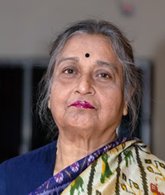 Dr. Nita Vidyarthi is a veteran critic of performing arts and writes on dance, music and theatre in leading publications. |